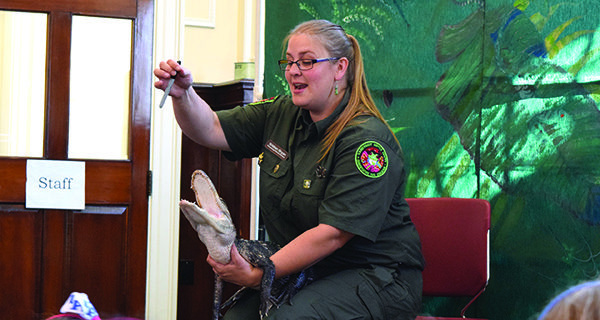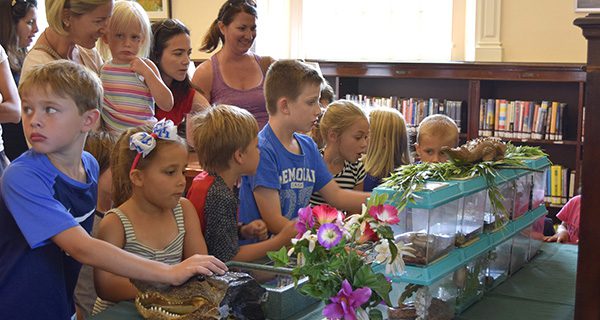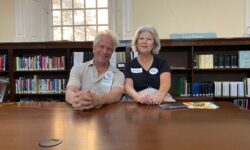[ccfic caption-text format="plaintext"]
Christina Perrone
Hometown Weekly Intern
“I have a question for you. Are alligators and crocodiles dinosaurs?” Kristen Bryan asked her young audience July 31, on a Monday afternoon at the Medfield Library. She put it up to a vote via hand raising.
“Alligators and crocodiles are one of the oldest animals on the earth, but they are not true dinosaurs. Alligators were never a velociraptor, alligators were never a t-rex, but they have ancient cousins that lived on this earth about 115 million years ago,” Bryan answered before opening one of the plastic crates she had brought.
From out of the box, Bryan pulled out a plastic replica of crocodilians’ oldest cousin, the Deinosuchus.

The first guest of the day was a smooth-fronted caiman affectionately named Loco. Despite their small stature, caiman are formidable predators, as they are one of the fastest land runners on earth - even faster than Usain Bolt. Photo by Christina Perrone
“Who noticed my 40 feet of blue tape, that went from that corner straight out the door?” Bryan pointed at the thin blue line on the carpet in front of her. “This ancient animal would have spanned 40 feet. That’s twice as big as the largest saltwater crocodiles in the world today.” After a dramatic pause, Bryan exclaimed: “Makes me kind of glad that we don’t have them today, because I’m not caring for something that big!”
Bryan continued to tell the children that she is a herpetologist: “Now guys, being a herpetologist doesn’t always mean that I get to just study animals and hang out in the wild. The reason I do what I do is I’m actually caring for thousands of animals. That is more animals than most zoos have.”
“I’m caring for them because people either have them and hurt them, or chose to throw them away,” said Bryan before introducing her first rescued reptile, a smooth-fronted caiman affectionately named Loco.
The grumpy little caiman made a grand entrance by whacking the side of its crate with its tail. A little girl shrieked before Bryan comforted her, “Oh, no worries! He’s here, you’re there. He has no reason to come near you, because he has me to be grudgy at.” Scattered laughter ensued.
“They’re always going to be these crazy, chubby bulldogs, but are always going to stay short— for an alligator or a caiman,” Bryan said. Despite their small stature, caiman are formidable predators, as they are one of the fastest land runners on earth - even faster than Usain Bolt.
“Little caiman like this do one of the coolest things of all crocodilians in the world. He is going to sit in that bush, and then he’s going to use that amazing speed and that power… and what is he going to do?” she paused. “He’s going to catch a porcupine.”
Caimans are native to South America, where porcupines have short quills, unlike North American porcupines, whose quills resemble long hair. “He’s going to grab that porcupine, and he’s going to shake it. And it’s going to send quills everywhere. But that means he can eat something as cool as a porcupine without getting hurt from the quills,” claimed Bryan.
One girl gasped, “But I love porcupines!”
“Oh I totally love porcupines, and I’m sorry that I said it,” Bryan was quick to assure her. “Unfortunately, when you’re in the wild, you have to eat whatever you can find.” Indeed, caiman can eat nearly anything they find, not just porcupines.
Next, Bryan attempted to put Loco back into his plastic lair. However, Loco had an ulterior motive. The young audience roared with laughter at the sight of Loco’s head and front legs triumphantly popping up over the crate. “I know! It’s so hard to be little!” laughed Bryan before Loco ultimately surrendered.
“So, I have a really important question for you,” began Bryan. “Does anyone know what this is?” she said, holding an egg of the size you’d find at a supermarket. One kid asked if it was a hard boiled egg.
“This is a bird egg. You know how I can tell?” She tapped the side of the egg with her fingernails. “Bird eggs are known for having a very thin shell on the outside.” It turned out to be a duck egg, which is the same size as a large crocodile egg in places like Africa. Unlike a duck egg, a crocodile’s egg sounds like dried out leather.
“And depending on how warm that nest is - if it’s below 90 degrees or above 90 degrees - will change if you get boys or girls,” Bryan said, pulling out her next guest, a baby American alligator named Bits.
No one could resist Bits’ charm. Less than a year old, baby Bits was the size of Bryan’s hand.
The next portion of the talk was about adaptations. Bryan took out a skull of crocodile to demonstrate a prized adaptation of the crocodilian: “Alligators and crocodiles have some of the strongest bites in the world. A crocodile can bite down with over 3,000 pounds of pressure. Let me just put that into your head… They have a stronger bite than a hippopotamus, they have a stronger bite than a rhinoceros, they have a stronger bite than a shark, they have a stronger bite than a tiger or a lion. They have the strongest bite known to man.
“Things like their very, very sharp teeth, the fact that they can see out of the side of their head in almost a full circle, and that they have bones that keep them warm,” Bryan continued, “are what’s called an A-DAP-TATION.”
“And all that an adaptation is, is something that we’re born with or something that we get that makes our life better, and makes it more possible for us to live in the world.”
“And this,” she held up a small, rectangular bone, “is one of the coolest adaptations you will ever see on an alligator or crocodile.” Kids then guessed what this odd bone could do for a crocodilian.
“This is what’s called an osteoderm. It’s a flat bone that sticks to the back scales and warms their body. Crocodilians are one of the only animals in the world to have this. It keeps them warm and it keeps them safe.” This adaptation is called thermoregulation, and it even inspired the solar panel.
Per Bryan, “The gentleman who discovered solar panels, who came up with this amazing idea of soaking up the heat and the energy from the sun, knew about these bones.”
The last section of Bryan’s presentation was about people keeping alligators and crocodiles for pets. “Now guys,” she said, “every animal that I brought to you this morning has come to us in what’s called confiscation. It has come from someone’s home that has owned them out with any kind of permission.”

When the sharpie lid touched the roof of Fluffy’s mouth, his jaw shut like a mouse trap. According to Bryan, crocodilians have sensors on the roof of their mouths and tongues that activate this reflex. Until something touches a sensor on the roof of the mouth or tongue of a crocodilian, its jaw will remain open. Photos by Christina Perrone
Unfortunately, “Too many people are still looking at [alligators and crocodiles] as small and cute and getting them - even when you’re not allowed to have them in your home,” she said regretfully.
“That smooth-fronted caiman came to us from a home in New Hampshire. That itty-bitty baby alligator came to us from a home in Long Island. The one I’m about to show you came from a home right here in Massachusetts,” stated Bryan.
“Here we have a winter that’s too cold to be the biggest reptile of North America. Guys, when an American alligator gets cold, they know that if they bury [themselves] in the mud of a river that they’ll stay warm for a night or an afternoon, but we can get sometimes get up to 10 feet of snow in one winter. So you think an alligator can live under that snow and feel safe?” asked Bryan.
The last critter, Fluffy the American alligator, was older and bigger than Bits. Bryan took out a sharpie from her pocket to demonstrate some of Fluffy’s reflexes. When the sharpie lid touched the roof of his mouth, his jaw shut like a mouse trap. Bryan said that until something touches a sensor on the roof of the mouth or tongue of a crocodilian, its jaw will remain open like a net for any ill-fated critter to enter.
Bryan then asked kids to raise one finger. “That’s how big a tooth can get for an alligator. A Nile or a saltwater crocodile’s teeth can get even larger,” claimed Bryan. “And guys, we get two sets of teeth in our life...alligators get a hundred sets of teeth. They get close to 6,000 teeth in their life.”
“Like I said, they are the largest predator in North America. They get up to 900 lbs!” she exclaimed. It was hard to imagine Fluffy reaching that size, as he was about the size and weight of a small terrier.
Before everyone left, Bryan let everyone hold Fluffy (whose mouth was taped shut) and pose for a candid. For those waiting to hold Fluffy, Bryan had other animals such as snakes, geckos, frogs, and turtles on display in small clear bins.
“I’m an environmental biologist by degree,” said Bryan after the talk. “I did my college internship with non-native reptiles, and I did my thesis and my independent study with native reptiles. And these guys,” referring to Rainforest Reptiles Shows, “took me in for my internship. And then I came back and said, ‘Okay, what do I do?’ and they said ‘You’re not leaving!’”
Now, Bryan travels around the area and teaches for the Beverly-based Rainforest Reptile Show: “We’re a half educational company and half non-profit sanctuary so that any of the animals that can’t go out and teach have the ability to stay in the sanctuary.”
Bryan’s favorite part of working with reptiles is giving them a new life.
“A lot of these animals we work with were abused and neglected, so sometimes our team is the first caring situations they’ve been put in … and for 1,000 animals to come to us - sometimes hundreds a year - that have really been through the ringer, it’s nice to be a caring home.”








